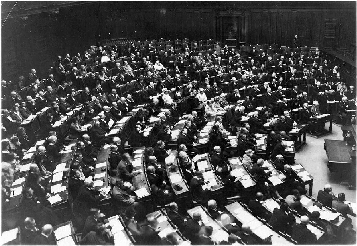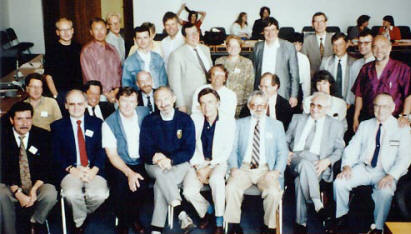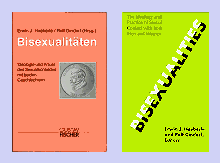Erwin J. Haeberle
History of the Hirschfeld Medal
Founder and Director, Magnus Hirschfeld Archive for Sexology at Humboldt University, Berlin, Germany.
Maintains the world's largest website on human sexuality. http://sexarchive.info/
Recipient of the WAS and EFS Gold Medals and the Medal of Sexology for Lifetime Achievement- AACS 2002
In November 1989, surprised and fascinated television audiences around
the world watched the sudden opening of the Berlin Wall. It had divided
the city for 28 years, but now, from one day to the next, people could
freely move back and forth. The border guards were still there, but
waved everyone through who could present an ID card or passport. Soon
enough, even these formalities were abandoned, because the quickly
unfolding events turned out to be revolutionary. Soon the East German
government collapsed, and this was followed, in due course, by the
re-unification of Germany. However, even during the first few weeks,
when the wall itself, with its many crossing points, was still standing,
German sexologists in East and West saw a new opportunity to meet and
cooperate. It would have been foolish and irresponsible not to seize it.
Indeed, the International Academy of Sex Research (IASR) had already
asked the East German Prof. Günther Dörner, an endocrinologist at the
medical school (Charité) of Humboldt University, to organize its annual
meeting in East Berlin for 1990. Unfortunately and unexpectedly, some
subsequent internal squabbling prompted the Academy to cancel its
original plan and to move the meeting to the small Swedish city of
Sigtuna instead. However, many foreign, and especially American,
colleagues had already made their travel arrangements and were very
eager to come to Germany. After all, because of the new political
situation, Berlin had become the world's most exciting tourist
destination. Especially my old friend, John De Cecco, the editor of the
Journal of Homosexuality, had been looking forward to a debate with
Dörner, who had proposed a controversial hormonal explanation of
homosexuality.
I had moved to West Berlin from San Francisco the year before when
nobody could yet imagine that the wall would come down so soon. At that
time, I was president of the German Society for Social-Scientific Sex
Research (DGSS), which was just preparing its next bi-annual meeting.
Encouraged by De Cecco, I therefore contacted Dörner about holding this
debate on his "home turf" after all, perhaps in the context of a jointly
organized event. Dörner readily agreed, and thus, in the next few
months, I crossed repeatedly though the wall and visited him in his
institute for the necessary preparations. Telephone service between the
two halves of the city was still quite inadequate, and we therefore had
to meet face to face for every little planning detail. Even so, our
discussions went very smoothly and turned out to be productive. In the
end, we came up with a two-part sexological congress to be held in both
East and West Berlin.
The first part was organized, just as originally envisioned by the
International Academy, by Dörner at the Medical School (Charité) of
Humboldt University. The second part, devoted to the subject of
"Bisexualities" was organized by the DGSS, and it was held in the
Reichstag, then the occasional, alternative home of the West German
parliament (its first home was still in Bonn).
Obtaining permission for a congress in the Reichstag was no small feat,
and it became possible only with the help of an influential politician:
Prof. Rita Süssmuth, who held the position of parliamentary president.
(For her support at this critical juncture and for her earlier
enlightened policies as the West-German Minister of Health she was later
awarded the Hirschfeld Medal.) Fortunately, she was well aware of the
special historical significance the building had for German sexology: In
1926, the Reichstag had seen the opening session of the second
international sexological congress, which had been organized by Albert
Moll. (The first one, convened by Magnus Hirschfeld, had taken place in
1921, also in Berlin.) However, the building was memorable for other
reasons as well: In February 1933, less than a month after Hitler had
become chancellor of Germany, the Reichstag burned under circumstances
that remain mysterious even to this day. Having become unusable as a
result of the fire, the building was abandoned by the Nazi parliament
which moved across the street into an opera house and never returned.
After the war, the damaged Reichstag interior was remodeled in a modern
and sober architectural style and served as an occasional locale for
various West German political events. After all, while standing very
close to the wall, the building was still located on West Berlin
territory.

Albert Moll's International Congress for Sex Research at the Reichstag in Berlin 1926
Now everything had changed again. Needless to say, holding our own first congress after the opening of the Berlin wall in such a historical building was, for us, a deeply satisfying achievement. Especially our Jewish congress participants felt a sense of triumph over the barbarism of the Nazis by reclaiming this historical site for sexology. Actually, as it turned out, ours was the last congress of any kind ever held there. A few years later, the whole Reichstag was wrapped in some special silvery foil by the artists Christo and Jeanne-Claude, turning it into a gigantic, shiny, widely admired temporary work of art. This was followed by a complete gutting of the building's interior and its reconstruction (including a new glass dome) by the British architect Sir Norman Foster. Today it is, once again, the one and only seat of the German parliament.

X. DGSS-Congress "Bisexualities" (July 13. - 15. 1990, Reichstag, Berlin)
Some congress participants during a break.
First row from the left: Rolf Gindorf, Erwin J. Haeberle, John Gagnon,
Milton Diamond, Richard Green, Martin Weinberg, Günther Dörner, John
Money
© 1990 M. Diamond.
This is not the place to discuss our two joint congresses of 1990 in detail. In any case, our DGSS part "Bisexualities" (the first scientific congress devoted specifically to this subject) was later published in book form, both in German and in English. Let it suffice to say that many members of the International Academy came to Berlin as originally planned (some attended the Sigtuna meeting as well).

Publication of the congress proceedings
In German "Bisexualitäten", 1994 (left) and English "Bisexualities", 1998 (right).
The books were edited by E. J. Haeberle and Rolf Gindorf
However, the event was also the occasion of awarding the first Hirschfeld Medals, and this may warrant a brief explanation.
It seemed to me that, for many reasons, our 1990 congress required a
special gesture, a lasting tribute to the Jewish pioneers of sexology
who had lived in Berlin and whose work had been destroyed by the Nazis.
The most important of these had undoubtedly been Magnus Hirschfeld
(1868-1935), the motor behind the world's first "gay liberation"
organization, the Scientific-Humanitarian Committee (1897), who had
edited the first Journal of Sexology (1908), founded the first
sexological society (1913), set up the first Institute for Sexology
(1919), and organized the first sexological congress (1921). He had
obtained his medical degree from the university in Berlin (Charité) and,
indeed, the latter had committed itself to taking over and continuing
his privately run institute an an official university institution after
his death. However, during the Nazi period and even after the war this
commitment was conveniently ignored. Even in 1990, there was no academic
sexological institution in Berlin on either side of the wall. It seemed
to me, therefore, that we had to come up with something that would
remind Germany and the world of Hirschfeld's largely forgotten legacy
and would honor his memory for many years to come.
After some agonizing, I finally hit upon the idea of creating a memorial
medal that the DGSS could award to outstanding colleagues during our
regularly scheduled meetings. The 1990 conference would offer a good
opportunity to start this new tradition. Inspired by this thought, I sat
down one afternoon and designed the medal I had in mind. (Eventually,
this first, spontaneous drawing was, without any changes, used for the
final product. If you look closely at Hirschfeld's portrait on the
medal, you can still see my artist's initials on his collar.)

Front (left) and back (right) of the Hirschfeld Medal for Sexual Science
The name of the various recipients is engraved on the back side
I also managed to raise some funds for the production of the medals, and
the DGSS vice president Rolf Gindorf found a suitable manufacturing
company to do the job. Thus, within a short time, we had a number of
gold medals at our disposal for the coming years. The only remaining
question was: To whom should the medals be awarded? We discussed this in
several administrative meetings and arrived at the following
conclusion:
Hirschfeld had considered himself both a scientist and a social
reformer, as expressed in his motto "Per scientiam ad justitiam!"
(Through science to justice!) In this spirit, he had been a tireless
advocate of sexual rights. Indeed, he had, among other things, created
and led a World League for Sexual Reform (WLSR) in the 1920's and early
1930's. He always believed that sex research should, sooner or later,
lead to concrete improvements in the lives of real people. Indeed, even
today, we sexologists are well advised to keep Hirschfeld's twin goals
in mind. It seemed appropriate, therefore, to award two medals at a
time at each of our conferences – one for sexual science and one for
sexual reform.
The first two recipients for 1990 were obvious choices. Both were of
advanced age, both had been victims of Nazi persecution, and both had
fought against great odds to become successful sexologists: The Austrian
Ernest Borneman and the Dutch Herman Musaph. The Jewish Borneman had
been born in Berlin, had fled into exile as a yong man, had spent many
years struggling in England, the USA and other countries, had finally
returned and become a citizen of Austria, where he authored many
important sexological studies. Musaph, also Jewish, had lived in the
underground during the war and later had become an important pioneer of
sexological medical education in the Netherlands.
This first decision was easily made and set the pattern for the
subsequent choices: We continued to feel that, first and foremost, we
should honor foreign sexologists, not only because they deserved it, but
also because it would remind them as well as their friends and
colleagues of Berlin as the birthplace of sexology as a science in its
own right. At the same time, it would help in gaining international
recognition for the award itself. The list of recipients over the last
18 years reflects these original intentions:
Recipients of the Hirschfeld Medal for Sexual Science:
Ernest Borneman (Austria), 1990
John P. De Cecco (USA), 1992
Liu Dalin (China), 1994
Jonathan Ned Katz (USA), 1997
Milton Diamond (USA), 2000
John Money (USA), 2002
Martin S. Weinberg (USA), 2004
Richard Green (UK) 2006
Recipients of the Hirschfeld Medal for Sexual Reform:
Herman Musaph (Netherlands), 1990
Imre Aszódi (Hungary), 1992
Ruth K. Westheimer (USA), 1994
Maj-Briht Bergström-Walan (Sweden), 1997
Oswalt Kolle (Netherlands), 2000
William Granzig (USA) and Manfred Bruns (Germany), 2002
Rolf Gindorf (Germany) 2004
Rita Süssmuth (Germany) 2006
Today, I am no longer president of the DGSS and, indeed, for several
years now, I have not even been a member. However, I am still proud of
having created the Hirschfeld Medal, and I hope that it will continue to
honor both the recipients and the sexological society which awards it.
Berlin, February 2008